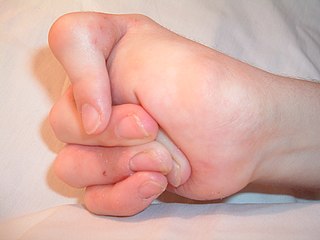
Ectodermal dysplasia (ED) is a group of genetic syndromes all deriving from abnormalities of the ectodermal structures. More than 150 different syndromes have been identified.

Pacman dysplasia is a lethal autosomal recessive skeletal dysplasia. The dysplasia is present during fetal development.

Freeman–Sheldon syndrome (FSS) is a very rare form of multiple congenital contracture (MCC) syndromes (arthrogryposes) and is the most severe form of distal arthrogryposis (DA). It was originally described by Ernest Arthur Freeman and Joseph Harold Sheldon in 1938.

Hay–Wells syndrome is one of at least 150 known types of ectodermal dysplasia. These disorders affect tissues that arise from the ectodermal germ layer, such as skin, hair, and nails.

Zunich–Kaye syndrome, also known as Zunich neuroectodermal syndrome, is a rare congenital ichthyosis first described in 1983. It is also referred to as CHIME syndrome, after its main symptoms. It is a congenital syndrome with only a few cases studied and published.

Revesz syndrome is a fatal disease that causes exudative retinopathy and bone marrow failure. Other symptoms include severe aplastic anemia, intrauterine growth retardation, fine sparse hair, fine reticulate skin pigmentation, ataxia due to cerebellar hypoplasia, and cerebral calcifications. Its effects are similar to that of Hoyeraal-Hreidarsson syndrome. It is a variant of dyskeratosis congenita.
Oculodentodigital syndrome is an extremely rare genetic condition that typically results in small eyes, underdeveloped teeth, and syndactyly and malformation of the fourth and fifth fingers. It is considered a kind of ectodermal dysplasia.

Boomerang dysplasia is a lethal form of osteochondrodysplasia known for a characteristic congenital feature in which bones of the arms and legs are malformed into the shape of a boomerang. Death usually occurs in early infancy due to complications arising from overwhelming systemic bone malformations.
Frontonasal dysplasia (FND) is a congenital malformation of the midface. For the diagnosis of FND, a patient should present at least two of the following characteristics: hypertelorism, a wide nasal root, vertical midline cleft of the nose and/or upper lip, cleft of the wings of the nose, malformed nasal tip, encephalocele or V-shaped hair pattern on the forehead. The cause of FND remains unknown. FND seems to be sporadic (random) and multiple environmental factors are suggested as possible causes for the syndrome. However, in some families multiple cases of FND were reported, which suggests a genetic cause of FND.

EEM syndrome is an autosomal recessive congenital malformation disorder affecting tissues associated with the ectoderm, and also the hands, feet and eyes.

Gerodermia osteodysplastica (GO), is a rare autosomal recessive connective tissue disorder included in the spectrum of cutis laxa syndromes.

Lelis syndrome it is a genetic disorder, a rare condition with dermatological and dental findings characterized by the association of ectodermal dysplasia with acanthosis nigricans. Other clinical features may include palmoplantar hyperkeratosis, nail dystrophy, intellectual deficit, disturbances of skin pigmentation and hypodontia. Transmission is autosomal recessive.

Hydrops-ectopic calcification-moth-eaten skeletal dysplasia is a defect in cholesterol biosynthesis. Greenberg characterized the condition in 1988.

Scalp–ear–nipple syndrome is a condition associated with aplasia cutis congenita.

Oligodactyly is the presence of fewer than five fingers or toes on a hand or foot.

Fryns syndrome is an autosomal recessive multiple congenital anomaly syndrome that is usually lethal in the neonatal period. Fryns (1987) reviewed the syndrome.
Dermoodontodysplasia is dental problems, trichodysplasia, and nail and skin problems.
Acro–dermato–ungual–lacrimal–tooth syndrome is a rare genetic disease. It is an autosomal dominant form of ectodermal dysplasia, a group of disorders that affects the hair, teeth, nails, sweat glands, and extremities. The syndrome arises from a mutation in the TP63 gene. This disease was previously thought to be a form of ectrodactyly–ectodermal dysplasia–cleft syndrome (EEC), but was classified as a different disease in 1993 by Propping and Zerres.

Gómez–López-Hernández syndrome (GLH) or cerebellotrigeminal-dermal dysplasia is a rare neurocutaneous (Phakomatosis) disorder affecting the trigeminal nerve and causing several other neural and physical abnormalities. Gómez–López-Hernández syndrome has been diagnosed in only 34 people. Cases of Gómez–López-Hernández syndrome may be under-reported as other diseases share the characteristics of cerebellar malformation shown in Gómez–López-Hernández syndrome. Gómez–López-Hernández syndrome was first characterized in 1979.

Marfanoid–progeroid–lipodystrophy syndrome (MPL), also known as Marfan lipodystrophy syndrome (MFLS) or progeroid fibrillinopathy, is an extremely rare medical condition which manifests as a variety of symptoms including those usually associated with Marfan syndrome, an appearance resembling that seen in neonatal progeroid syndrome, and severe partial lipodystrophy. It is a genetic condition that is caused by mutations in the FBN1 gene, which encodes profibrillin, and affects the cleavage products of profibrillin, fibrillin-1, a fibrous structural protein, and asprosin, a glucogenic protein hormone. As of 2016, fewer than 10 cases of the condition have been reported. Lizzie Velásquez and Abby Solomon have become known publicly through the media for having the condition.








